Hyundai Accent: Button Engine Start System / Description and Operation
– Human machine interface through a 1-stage button, for terminal switching and engine start.
– Control of external relays for ACC / IGN1 / IGN2 terminal switching and STARTER, without use of mechanical ignition switch.
– Steering column locking with an ESCL device; Monitoring of the vehicle status to insure safe activation of the ESCL.
– Indication of vehicle status through LED or explicit messages on display.
– Immobilizer function by LF transponder communication between fob and start/stop button.
– Redundant architecture for high system dependability .
– Interface with Low Speed CAN vehicle communication network.
– Interface with LIN vehicle communication network depending on platform .
The RKE and SMART KEY functions are not considered part of this Button Engine Start system and are specified in separated system.– Steering column locking/unlocking with ESCL.
– Switching of ACC / IGN1 / IGN2 terminals.
– Control of the STARTER relay BAT line (high side) based on communication with EMS ECU.
– Management of the Immobilizer function.
– Management of BES warning function.
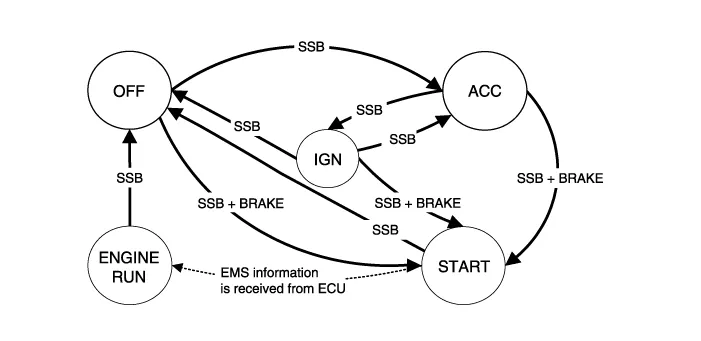
• Control Ignition and engine ON/OFF by Sending signal to IPM.
• Display status by LED Lamp ON/OFF. (Amber or Blue)
| No | Character lamp | Conditions |
| 1 | Indicator Lamp ON | Door open, Tail lamp ON, ACC, IG ON |
| 2 | Indicator Lamp 30sec ON → Lamp OFF | Door close, Tail lamp OFF, IG OFF |
| 3 | Indicator Lamp OFF | Remote LOCK, Passive LOCK |
| 4 | Rheostat at tail lamp ON (Illumination lamp) | |
| No | Ignition conditions | Start Button LED status |
| 1 | IG OFF | LED OFF |
| 2 | IG ACC | Amber color LED ON |
| 3 | IG ON (Engine OFF) | Blue color LED ON |
| 4 | Cranking | Maintain LED status before cranking |
| 5 | Engine running | LED OFF |
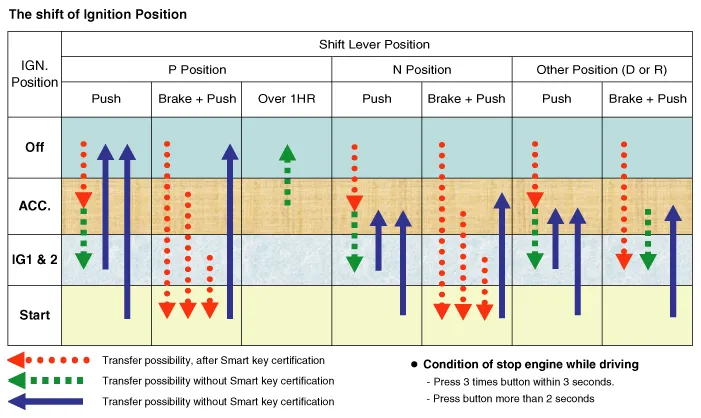
– Non-smart key RKE
– SMART KEY FOB
Currently the BES system comprises with SMART KEY FOB always.The transmitter, receiver and antennas required for the communication between the fob and the vehicle will differ depending on functionalities and regional areas.The RKE and SMART KEY functions are in separated documents. Refer to Smart key system for more detailed information about SMART KEY function.• "Start Stop Button (SSB) monitoring",
• "Immobilizer communication" (with Engine Management System unit for immobilizer release),
• "ESCL control",
• "Authentication server" (Validity of Transponder and in case of Smart Key option Passive Fob authentication ),
• "System consistency monitoring",
• "System diagnosis",
• Control of display message / warning buzzer .
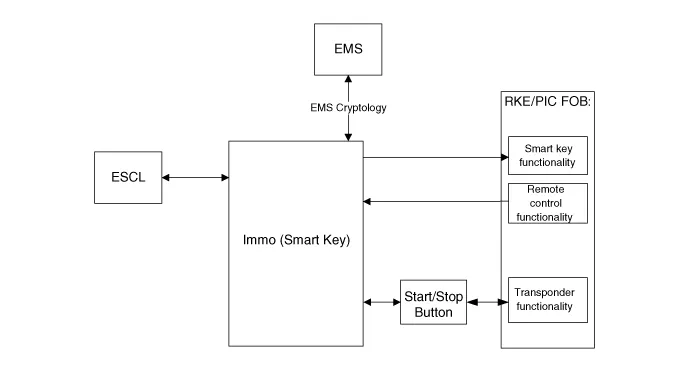

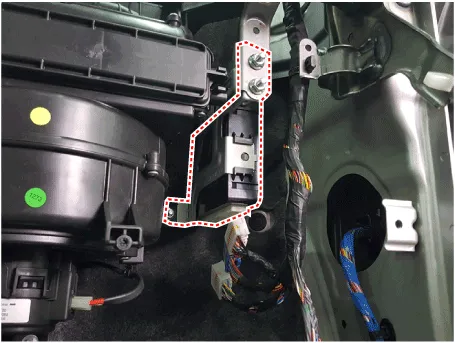
• "Start Stop Button (SSB) monitoring",
• "Immobilizer communication" (with Engine Management System unit for immobilizer release),
• "Authentication server" (Validity of Transponder and in case of Smart Key option Passive Fob authentication ),
• "System consistency monitoring",
• "System diagnosis",
• Control of display message / warning buzzer.
The unit behaves as Master role in the whole system. In case of SMART KEY application, for example "Passive Access”, "Passive Locking” and "Passive Authorization are integrated for Terminal switching Operations”. It collects information about vehicle status from other modules (vehicle speed, alarm status, driver door open...), reads the inputs (e.g. SSB, Capacitive Sensor / Lock Button, PARK position Switch), controls the outputs (e.g. exterior and interior antennas), and communicates with others devices via the CAN network as well as a single line interfaces. The diagnosis and learning of the components of the BES System are also handled by the SMK. The SMK manages the functions related to the "terminal control" by activating external relays for ACC, IGN1 and IGN2. This unit is also responsible for the control of the STARTER relay. The SMK is also controlling the illumination of the SSB as well as the "system status indicator", which consists of 2 LEDs of different color. The illumination of the fob holder is also managed by the SMK. The SMK reads the inputs (Engine fob in, vehicle speed, relays contact status), controls the outputs (Engine relay output drivers), and communicates with others devices via the CAN. The internal architecture of the SMK is defined in a way that the control of the terminal is secured even in case of failure of one of the two microcontrollers, system inconsistency or interruption of communication on the CAN network. In case, failure of one of the two controllers, the remaining controller shall disable the starter relay. The IGN1 and IGN2 terminals relays shall be maintained in the state memorized before the failure and the driver shall be able to switch those IGN terminals off by pressing the SSB with EMERGENCY_STOP pressing sequence. However, engine restart will not be allowed. The state of the ACC relay will depend on the type of failure. The main functions of the SMK are :• Control of Terminal relays
• Monitoring of the Vehicle speed received from sensor or ABS/ESP ECU.
• Control of SSB LEDs (illumination, clamp state).
• Control of the base station located in SSB through direct serial interface.
• System consistency monitoring to diagnose SMK failure and to switch to relevant limp home mode.
• Providing vehicle speed information
• Start Stop Button (SSB) monitoring
• Starter power control
• To activate the power modes ‘Off’, ’Accessory’, ‘Ignition’ and 'Start' by switching the corresponding terminals
• To start the engine
• To stop the engine
The contact will be insured by a micro-switch and a backlighting is provided to highlight the marking of the button whenever necessary.Two (2) LED colors are located in the center of the button to display of the status of the system. Another illumination LED is also integrated into the SSB for the lighting of the "Engine Start/Stop" characters.

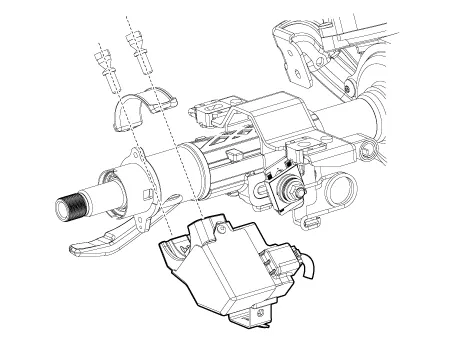
| System State | Terminal Status | ESCL Status | Engine Status |
| 1. OFF - Locked | OFF | Locked | Stopped |
| 2. OFF - Unlocked | OFF | Unlocked | Stopped |
| 3. ACC | ACC | Unlocked | Stopped |
| 4. IGN | IGN1, IGN2, ACC | Unlocked | Stopped |
| 5. Start | IGN1, Start | Unlocked | Cranking |
| 6. IGN - Engine | IGN1, IGN2, ACC | Unlocked | Running (means "self-running") |
Referring to the terminals, the system states described in the table above are same as those one found in a system based on a mechanical ignition switch. The one of distinction with Mechanical-Ignition-Switch based system is that the BES system allows specific transition from [OFF] to [START] without going through [ACC] and [IGN] states.
| System State | Terminal Status | ESCL Status | Engine Status |
| 1. OFF - UNLOCKED | OFF | Unlocked | Stopped |
| 2. ACC | ACC | Unlocked | Stopped |
| 3. IGN | IGN1, IGN2, ACC | Unlocked | Stopped |
| 4. Start | IGN1, START with special pattern of activation see Chap 6.2.1 for details | Unlocked | Cranking |
| 5. IGN - Engine | IGN1, IGN2, ACC | Unlocked | Running (means "self-running") |
Referring to the terminals, the system states described in the table above are same as those one found in a system based on a mechanical ignition switch. The one of distinction with Mechanical-Ignition-Switch based system is that the BES system allows specific transition from [OFF] to [START] without going through [ACC] and [IGN] states.
Other information:
Hyundai Accent (HC) (2017 - 2022) Service Manual: Transmission Control Module (TCM)
- Components 1. Transmission control module (TCM) - Description The module receives and processes signals from various sensors and implements a wide range of transmission controls to ensure optimal driving conditions for the driver.Functions • Monitors the vehicle's operating conditions to determine the optimal gear setting. • Performs a gear change if the current gear setting differs from the identified optimal gear setting.Hyundai Accent (HC) (2017 - 2022) Service Manual: Evaporator Temperature Sensor
- Description The evaporator temperature sensor will detect the evaporator core temperature and interrupt compressor relay power in order to prevent evaporator from freezing by excessive cooling. The evaporator temperature sensor has the Negative Temperature Coefficient (NTC). Electrical resistivity of NTC will increase with decreasing temperature and decrease with increasing temperature.
Categories
- Manuals Home
- Hyundai Accent Owners Manual
- Hyundai Accent Service Manual
- New on site
- Most important about car


